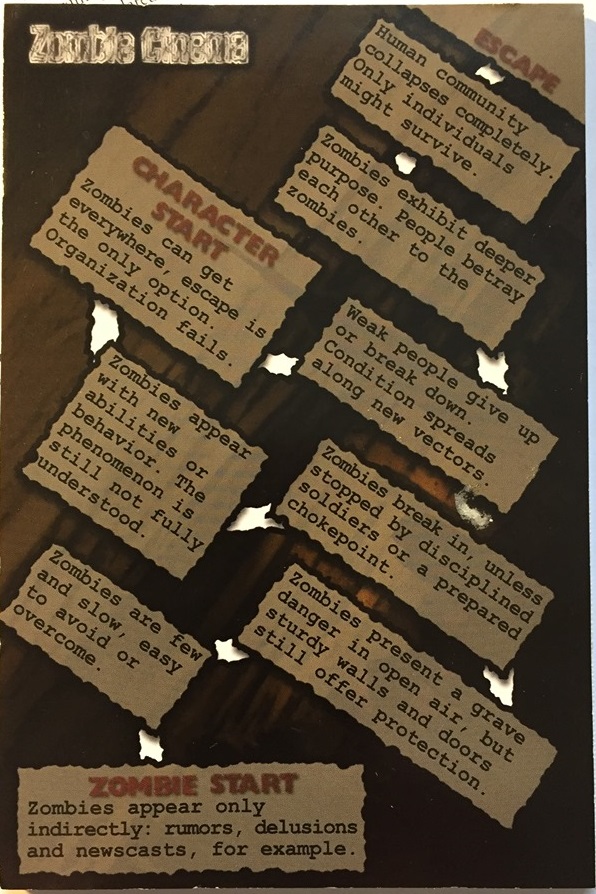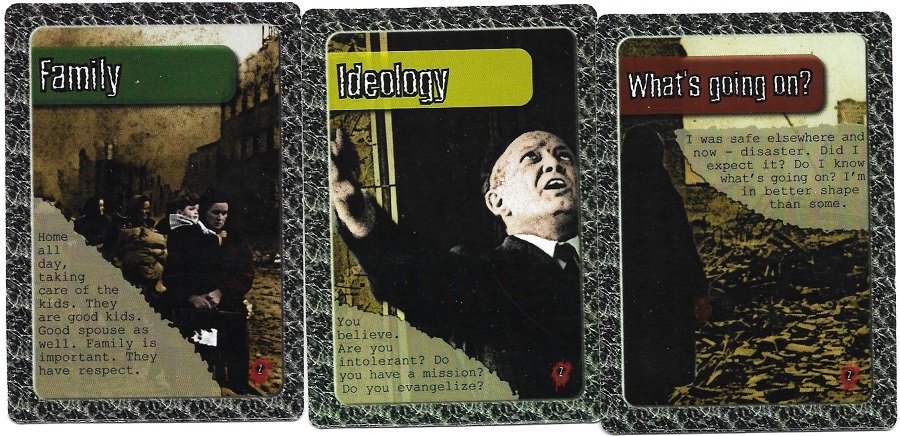Among several quick-play games or play-materials we brought to Närcon, I made sure to include Zombie Cinema. Different people find different games to ideal for introducing play, and for me, this is among my top three.
It uses a board, but you don’t play on it in an ordinary board game sense. It’s a content-device. When the turn marker comes to you, you examine the boxes which currently hold pawns and those, and those alone, are the specifications for your framing and ongoing input during this turn. Depending on how spread out pawns become, sometimes it’s as few as two (as at the start), or sometimes you’re reading four or five.

Significantly, during one of these sessions, someone internalized it out loud by saying “Ohh, so we’re not trying [to compete to] to win by getting off the board,” in a very positive and excited way. The “Escape” position is merely one way for a character to leave play, among others. I also saw it in both sessions during the first turn, when everyone collectively realized that conflicts were run only between characters, not against the zombies, and grinned at one another around the table. [For clarity, after a player-character has left play in any way, conflicts against the zombies are sometimes possible.]
At this late date, I’m mildly miffed that this game and Cold Soldier have to be about zombies especially since they work so well exactly with this content. For one thing, the topic has been diluted by so much re-treading since the late 2000s, and for another, I’d like to be able to introduce role-playing with a wider range of content for options. I also use my preferred application of The Pool and a few other things, but I do wish for more systems as specific and dynamic as these which happen to be about something else … [the recent Tales of the Round Table may qualify, although I’m not used to it yet].
The first game was set right “here and now” at the convention itself, which I’m sure you’ll recognize as a common choice for zombie or murder convention play. Obviously, we had handy maps and personal familiarity with many of the spaces, so play was always well-oriented in spatial terms. Here are the notes I took about the characters as we created them. I know my handwriting is awful; it’s not so important for you to learn the content as to recognize this as a technique at the table.
So you at least know what you’re looking at, if not actually to read it easily, the characters are created by drawing cards: one green, one yellow, and one red. For example, this was the result which became Anna, interpreting the cards to “housewife with three kids, antivax [plus related topics], first time out in a long time and unfamiliar with the convention.”

In this game, not surprisingly given our setting, the thematic tag or underpinning for the zombies was cosplaying, which was both a bit funny and legitimately creepy. Having both a naive paramedic and a shut-in antivaxer – each with family present – was obviously slated for conflict from the beginning and also put a little teeth into the familiar trope of “zombie virus,” especially since the Cause o’Zombies wasn’t ever established for sure.
The big point, though, and it applies for the second game too, is that we made a nice collective effort regarding the mandated content “Zombies exhibit deeper purpose,” when it appeared. In this case it included – through different people’s input and development of one another’s – a gathering at the Zen Garden (an actual place nearby), some kind of dreadful realm-ripping-open portal, and an actual Zombie King, with particularly unfortunate cosplay. It never received a real explanation but it didn’t have to, winning on visuals alone.
The second game, played with entirely different people except for me, was set on the ferry operating among Sweden, Denmark, and Germany, as suggested by one of the participants. I have also been on that ferry so we were able to operate as “living maps” for everyone else. As you can see from the lead image, these are very big ships which include several garage decks for hundreds of vehicles, rather than the small and pragmatic concept of a ferry.
In this game, we tended less toward creepy and more toward splatter, as someone enthusiastically mentioned about halfway through, including some notable combat. It also featured a rapid-fire kill-off for all but one player-character (Ichi), who had a chance to stop the whole thing in a conflict with the zombies at the end, but failed in the final roll. Therefore, unlike the first game in which the zombies’ (mysterious) portal-opening goal failed as well as all the characters dying, in this one, the story ends with the zombie-controlled ferry easing gently into dock at Rostock … for what nefarious end, we do not know.
Again, as with the first game, the “Zombies exhibit deeper purpose” was honored as a situational component with more bite toward/at the end than one might have anticipated.
Here’s a critical system point, well worth noting and applying elsewhere, which arose via rules/role clarification in both games: the turn holder (cough*GM of the moment) has to name a location and state which player-characters are present. They do not have to account for the player-characters who are absent, effectively freeing them up for someone else to consider later. I hadn’t really noticed before how important this was, both in terms of relaxing expectations for anyone to know everything about all the player-characters while GMing, and I think it can be applied well in games where one person holds the scene-framing job throughout.
Finally: these sessions and others with some prepared systems were played very much as follow-up and fun-activity for the workshops that I conducted at the convention, and as explicit invitation to see what Adept Play is about. I’m not very good at recruitment and members-oriented promotion, partly due to my social and ethical ambiguity about it, and this seemed like the most honest and least greasy way. It’s a work in progress.


8 responses to “Can’t escape the zombies”
While it’s not my favorite way of doing things, I think it’s interesting to have the role of DMing go around the table.
And for me, it’s a good exercise in not being indecisive and just going with things.
But it’s also much harder and more mentally tiring for me than just playing a game with a fixed DM and only have to worry about myself and how I affect the world.
I do think that it has something to do with having to come up with things on the fly in a very short amount of time and not being used to it.
So, I think with practice and working those “creativity muscles”, that’d probably change.
It would be interesting to see the “shared DM mechanic” being used for a game like D&D, with so many rules and which normally requires a lot of preparation and rules knowledge. Could it be done?
It feels like one big thing with games like D&D, with a single DM, is that the DM can keep the NPC working towards a secret goal, which the players then can go “Ooohhhh!” over when they inevitably destroy the DMs plans.
How could things like secret story points and puzzle challenges and things like that be handled with shared DMship?
It was fun to try Zombie Cinema out though, thanks for hosting!
Så brå att du skriva här, tusen tack!
It’s a good opportunity to pull apart some variables which really have nothing to do with one another, but which are often mistaken to be a single thing.
There are two big categories.
Knowing the rules, referencing them, and applying them, distinct from anyone else doing it
Using specific rules and responsibilities that others don’t have
About those: I’ve learned they’re not the same thing. During play, if I’m not the most expert with the textual rules, or even if if I know them well but another person feels like taking on the job, then I’m happy for someone else to keep an eye on when we should apply procedures and how to do them. It turns out not to compromise play in any way. One doesn’t have to be Rules King in order to be a GM.
Things get more interesting if we focus just on the second point (in-game procedures) and dissect it into many different tasks, including but not limited to the following:
1. Stating the location and who’s present
2. Knowing relevant things that the other players don’t
3. Stating the outcomes of resolved actions and events, as well as their consequences
One of my big lessons to have learned over the past three decades is that these (and others) can be combined and separated into any combination. In our Zombie Cinema game, #1 moved from person to person via the turn marker, #2 moved from person to person based on the dice outcomes (and assuming the “higher purpose” box is in play), and #3 moved from person to person based on dice outcomes. Whereas in another game that was showcased at the convention, #1 is always the same person throughout play, #2 is developed via many people’s narrations but the developing total is always applied by that same person, and #3 moves from person to person based on dice outcomes. And finally, in yet another, The Pool, #1 and #2 are done by the same single person throughout play, but #3 moves from person to person based on dice outcomes. There are other combinations too, as in Primetime Adventures: #1 moves from person to person, but #2 is always the same person throughout play, and #3 depends on card outcomes. They all work at the basic level of “can we play,” “do things happen,” and “what’s going on.”
Of all of these, I think #2, the one that you highlighted, is the most affected by centralizing vs. distributing its application. I agree with you that keeping it (a fixed, relevant backstory) with one person allows for certain special properties.
If you’re interested in more thoughts about GMing and how it works, I have a little presentation in Slaying the “The”.
Sorry Ron, I think I’m missing something — what are you referring to with the #numbers?
Shoot, I messed up that formatting quite badly. I’m fixing it in the comment.
I’d be interested in trying both The Pool and Zombie Cinema (actually a matter of national pride being a finn …). What was the third game you like to play with beginners, Ron?
At this event, we prepared some materials for The Pool (based on the Galactic Peace game presented here a while ago) and InSpectres. I also have several informal, or improvised packets of material to use for a variety of games that I like to scatter around a table, and play whatever catches someone’s interest.
It may or may not surprise you that I don’t think there are any distinctive features that add up to “good for beginners.” The only thing that matters is that play is forthright, active, and honest, with prccedures that aren’t fetishes or lying masks for a controlled experience.
Even rather complex rules-sets are suitable in that context. A bit of full-on original RuneQuest Strike Rank critical hit/miss fighting + spirit combat is as good as a bit of frog fantasy combat vs. a five-headed cobra using The Pool.
Therefore my choice of titles at events like these is not about simplicity or lack of threat or anything else often associated with introductory play or design. It’s mainly about what I think is right for the people who may be present there.
You don’t feel the pressure that newcomers expect something along the lines of DnD5? Last time I was going to introduce a friend to role playing I could see her disappointment when I took out 3d6 and told her that’s all that would be needed for tonight’s game. (Unfortunately we never had the chance to play but that’s another story.)
I guess there are two variables to consider: what they may feel or expect, and what I feel about that. I confess that I am not very sophisticated in my emotions, i.e., they are powerful but simple, so I don’t often “feel about feelings,” if that makes any sense. I was going to say that if any such thing is happening, I don’t care, if I even notice.
However, now that I think about it, there’s another distinction at work. The last time I introduced role-playing to a friend I already knew was a long time ago, maybe 15 years, and the gap before that was really long too. I introduce role-playing to a lot of people these days, but now the context is more formal, not embedded in personal relationships.
Therefore I’m probably not even eligible to answer in any insightful way, because the dynamics of introducing play for me are framed in a way that seems to get past that question. A lot of people who I meet this way do mention seeing D&D 5th edition in videos, bu it never represents or develops into any reactions regarding what we do next.